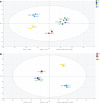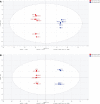Integrative analysis of sensory evaluation and non-targeted metabolomics to unravel tobacco leaf metabolites associated with sensory quality of heated tobacco
- PMID: 36844088
- PMCID: PMC9944805
- DOI: 10.3389/fpls.2023.1123100
Integrative analysis of sensory evaluation and non-targeted metabolomics to unravel tobacco leaf metabolites associated with sensory quality of heated tobacco
Abstract
Introduction: Heated tobacco (Nicotiana tabacum L.) products are heating tobacco plug at a temperature of 350°C and produce different emissions in aerosol and sensory perceptions of tobacco leaf compared with combustible tobacco. Previous study assessed different tobacco varieties in heated tobacco for sensory quality and analyzed the links between sensory scores of the final products and certain chemical classes in tobacco leaf. However, contribution of individual metabolites to sensory quality of heated tobacco remains largely open for investigation.
Methods: In present study, five tobacco varieties were evaluated as heated tobacco for sensory quality by an expert panel and the volatile and non-volatile metabolites were analyzed by non-targeted metabolomics profiling.
Results: The five tobacco varieties had distinct sensory qualities and can be classified into higher and lower sensory rating classes. Principle component analysis and hierarchical cluster analysis showed that leaf volatile and non-volatile metabolome annotated were grouped and clustered by sensory ratings of heated tobacco. Orthogonal projections to latent structures discriminant analysis followed by variable importance in projection and fold-change analysis revealed 13 volatiles and 345 non-volatiles able to discriminate the tobacco varieties with higher and lower sensory ratings. Some compounds such as β-damascenone, scopoletin, chlorogenic acids, neochlorogenic acids, and flavonol glycosyl derivatives had strong contribution to the prediction of sensory quality of heated tobacco. Several lyso-phosphatidylcholine and lyso-phosphatidylethanolamine lipid species, and reducing and non-reducing sugar molecules were also positively related to sensory quality.
Discussion: Taken together, these discriminating volatile and non-volatile metabolites support the role of leaf metabolites in affecting the sensory quality of heated tobacco and provide new information on the types of leaf metabolites that can be used to predict applicability of tobacco varieties for heated tobacco products.
Keywords: discriminating metabolites; heated tobacco products; non-targeted metabolomics profiling; orthogonal projections to latent structures discriminant analysis; sensory evaluation.
Copyright © 2023 Zhao, Shang, Tian, Gao, Song, Peng, Li and Wang.
Conflict of interest statement
Authors SS and YT were employed by China Tobacco Yunnan Industrial Co., Ltd, author ZL was employed by Qujing tobacco company. The remaining authors declare that the research was conducted in the absence of any commercial or financial relationships that could be construed as a potential conflict of interest.
Figures




Similar articles
-
Metabolome of flue-cured tobacco is significantly affected by the presence of leaf stem.BMC Plant Biol. 2023 Feb 13;23(1):89. doi: 10.1186/s12870-023-04093-2. BMC Plant Biol. 2023. PMID: 36782114 Free PMC article.
-
Distinct Changes in Metabolic Profile and Sensory Quality with Different Varieties of Chrysanthemum (Juhua) Tea Measured by LC-MS-Based Untargeted Metabolomics and Electronic Tongue.Foods. 2024 Apr 1;13(7):1080. doi: 10.3390/foods13071080. Foods. 2024. PMID: 38611384 Free PMC article.
-
Flavor properties of post-heated fermented milk revealed by a comprehensive analysis based on volatile and non-volatile metabolites and sensory evaluation.Curr Res Food Sci. 2024 Oct 26;9:100892. doi: 10.1016/j.crfs.2024.100892. eCollection 2024. Curr Res Food Sci. 2024. PMID: 39525388 Free PMC article.
-
An overview of plant volatile metabolomics, sample treatment and reporting considerations with emphasis on mechanical damage and biological control of weeds.Phytochem Anal. 2014 Jul-Aug;25(4):331-41. doi: 10.1002/pca.2486. Epub 2013 Dec 18. Phytochem Anal. 2014. PMID: 24347157 Review.
-
The role of metabolomics in neonatal and pediatric laboratory medicine.Clin Chim Acta. 2013 Nov 15;426:127-38. doi: 10.1016/j.cca.2013.08.020. Epub 2013 Sep 11. Clin Chim Acta. 2013. PMID: 24035970 Review.
Cited by
-
Metabolomics-based study of chemical compositions in cellulase additives derived from a tobacco-origin Bacillus subtilis and their impact on tobacco sensory attributes.Arch Microbiol. 2024 Mar 14;206(4):163. doi: 10.1007/s00203-024-03876-x. Arch Microbiol. 2024. PMID: 38483624
-
Influence of anionic species on the low temperature pyrolysis performance of heated tobacco sheets catalyzed by sodium salts.Front Chem. 2024 Jun 12;12:1425244. doi: 10.3389/fchem.2024.1425244. eCollection 2024. Front Chem. 2024. PMID: 38933929 Free PMC article.
-
Correlation between sensory attributes and Metabolomic profiles of cocoa liquor from different cacao genotypes.Food Chem X. 2025 Apr 25;28:102498. doi: 10.1016/j.fochx.2025.102498. eCollection 2025 May. Food Chem X. 2025. PMID: 40475821 Free PMC article.
References
-
- Chen W., Gong L., Guo Z., Wang W., Zhang H., Liu X., et al. . (2013). A novel integrated method for large-scale detection, identification, and quantification of widely targeted metabolites: application in the study of rice metabolomics. Mol. Plant 6 (6), 1769–1780. doi: 10.1093/mp/sst080 - DOI - PubMed
LinkOut - more resources
Full Text Sources

